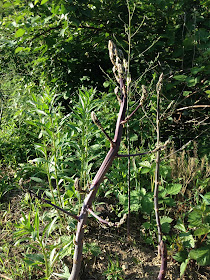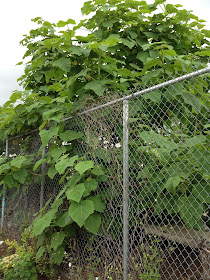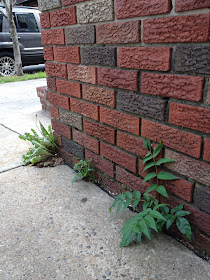FROG FOUND: JUST IN TIME
The other day, I received an urgent message from one of the many citybillies
following this blog: FOUND A FROG.
Just in time too. She sent the
following photo within the last days of the Frogs Return Moon:
This particular citybilly works in the produce section of a supermarket and,
as she was unpacking a box of local asparagus, she found a frog.
I think this photo would’ve really tickled the ancient Wheelmakers. Frog and asparagus, two totems of the second
spring moon of Wabun, the Golden Eagle.
We enter, this week, Wabun’s third and final moon of the year, the Corn
Planting Moon. It’s time to start
preparing for the long slog and the bountiful harvest of the upcoming summer
months. Most of the tree-flowers are gone,
the leaves are out, the frogs have returned and the asparagus? That quintessential spring crop? Time to let it go wild and weedy.
STALKING THE WILD ASPARAGUS
Just recently, I asked one of my farmer friends, “Why does asparagus season
have to end?”
I mean, as I understand
it, the asparagus shoots out of the ground, you let it grow, you snip it at the
base and you take it to market…then, a week later, another asparagus breaches
the surface…and it’ll keep coming back and coming back. “Can’t you just keep picking it all summer?”
“No time,” she said. “There’s too
much else coming up. Got to pick, got to
plant and you gotta weed.”
Gotta weed.
I went over to her place, the Urban Girls Produce farm located at the
Schuylkill Center, to watch the wild asparagus.
So this is what happens when asparagus goes wild. This is what happens to your favorite vegetable
when you gotta weed.
Trees can go to weed too. There is a
whole roster of trees that are unwanted, uninvited, undesired, blackballed and
ostracized. In the books, it’s called
spontaneous urban vegetation. In the
college classrooms, it’s sometimes called Urban Ecology. Down here on the mean streets, we call them
weed trees and I’ve found a couple worth talking about.
In The Urban Tree Book, Arthur
Plotnik writes: There is another way to
recognize mulberries: by slipping on the crush of slimy, sidewalk-staining
fruit that has ripened and fallen from the tree.
And that is actually exactly how I found this mulberry, as I was hunting for
weed trees in North Philly.
I literally slipped on the purple wash of wet fruit as I was walking down
north Seventh Street, kind of near Temple University.
There it was, growing behind the crumbling
brick wall, hanging over the dumping ground and just littering its fruit all
over the sidewalk. No wonder people don’t
like mulberries.
This is one of those cases, though, that makes you wonder.
Here you got a city corner that’s literally a trash pit: cinder blocks,
rotting pallets, pipes and tires, Arizona ice tea cans and Gatorade bottles,
wet trash bags, warm mulberries and one ugly carpet.
But which came first?
Did this become a trash pit because of the mulberry tree and its annoying
habit of dropping thousands of berries in its shade? Or did the mulberry tree flourish here because
this corner is nothing but a trash pit for the neighborhood? Either way, the two components of this corner
– trash and mulberries – are twins now.
Cleaning up this city corner will now require the removal of this
mulberry tree.
Such a shame too, because the actual mulberry fruit is delicious. It looks kind of like a blackberry and it
tastes like a wild grape. I like the
fruit, but the tree itself is just unfriendly and messy. I don’t care if it’s the subject of an
amazing Van Gogh painting, and I don’t care that, in China, the mulberry is revered
because the Bombyx mori caterpillar eats its leaves and spins all that
silk. Yes, this is the very same tree
that the worms eat and turn into silk.
It’s a historic tree, one of the trees that changed history. Great.
Good to know. Here in the city,
it’s a trash tree. Cross the street when
you see it coming, especially if you’re wearing nice shoes.
WEED TREE ROSTER
Here’s a quick run-down of common urban weed trees.
SASSAFRAS: This is a native understory tree, found along the edges and in
the lower canopy of the typical beech-maple forests of the northeast. In the city though, it’s a weed tree. It’s extremely tenacious. In fact, it reproduces by cloning and takes
over the abandoned edges of untended yards, weedy parks and unused
driveways. Where you see one sassafras,
you’ll see another right near it.
Another
shame too, because this tree – its leaves, barks and roots – are the essential
ingredients for two of America’s greatest contributions to world cuisine: the
gumbo and the sarsaparilla.
MIMOSA: I learned this plant’s name as the mimosa but, after a quick dive into my
Dendrology Library, I learn that its true name is the silk-tree. This tree deserves a better reputation. They have those elegant, fan-like leaves and
eventually they sprout a dazzling pink flower.
Too bad that I usually find it chasing the sunlight out of an overgrown
hedge, or creeping out between a sidewalk crack through a pile of trash bags.

CATALPA: The big chief of vacant lots, highway islands and train tracks, the
catalpa is one of the most successful plants in the city. This tree can, and will, grow anywhere.
SPONTANEOUS URBAN VEGETATION
People are always asking me: But, Jon Spruce, what makes this tree a weed
tree?
I guess, in the end, it is a value call.
A weed tree, after all, is just a very successful urban tree, able to
withstand pollution, salt, drought, compacted soil, noise, wind, dogs, construction,
urine, loud rap music and neglect. I
know, deep down inside of my green heart, that weed trees don’t cause vacant
lots and corner trash pits and bad neighborhoods. People don’t say: look, there’s a mulberry, I’ll
just dump my old carpet here in its shade.
No, weed trees are a symptom of urban blight, not the cause.
But that doesn’t mean I’m going to ever like stumbling across a mulberry or a
catalpa or any of the other weed trees that clog the city homesteads.
I’d like to appreciate them, I really would.
Take a look at this scene, right around Diamond and North 22nd
Street:
It’s actually quite lovely, almost pastoral, the tall tower of that spruce
just the perfect contrast to that giant humpback willow. There’s the unbroken fence riding out of the
green hedges and that long trail of ivy eating away at the red house. But right there, right in the middle, you can see the thin spires of the
ailanthus tree.
Ailanthus, the undisputed king of the weed trees. Friggin’ ailanthus.
I HATE AILANTHUS
You’ve seen the ailanthus tree.
I'm sure of it.
It
might be invisible to you because it’s just about everywhere.

 You’ve walked right by it, on your way to
work, to the movies, to a restaurant, to the dry cleaners, to Citizens Bank, to
the Art Museum, or on your way to the park to see some nature. You’ve probably parked your car next to
it.
You’ve walked right by it, on your way to
work, to the movies, to a restaurant, to the dry cleaners, to Citizens Bank, to
the Art Museum, or on your way to the park to see some nature. You’ve probably parked your car next to
it.
You’ve probably stood next to it,
waiting for the bus or waiting for the light to change. If these things were determined by number
alone, then the ailanthus would be the official tree of Philadelphia, probably
the official tree of the entire megalopolis.
It comes in all shapes and sizes.
It
grows on stoops or out of walls. It can
be thin and wiry or big and husky. It’s
a remarkable grower and it will climb its way fast to the sun through backyards
and alleyways.
It doesn’t suffer other
trees lightly. Take a good look at
it. The next time you pass one, break
off its leaf and snap it in half and take a good, deep smell. Burnt peanut butter. That’s what it smells like. It’s actually a chemical called ailanthene
and this tree pumps it into the ground to fend off all other vegetation.
I hate ailanthus.
In the academic tree world, there is a current movement that is saying, swallow
your pride and learn to like the ailanthus.
These brainiacs in their climate-controlled classrooms? They’re asking us citybillies to put aside
our hatred and to appreciate the ailanthus for what it is: one of the most
successful plants to ever survive in the urban environment. They say that the ailanthus can be used as a
gateway plant to help younger generations appreciate nature, that the ailanthus
is sometimes the only nature that some city dwellers will ever encounter. Ailanthus, they say, is just as good as any
other tree in getting rid of all that noxious carbon dioxide and turning it
into fresh air. They say that, if not
for the ailanthus, many neighborhoods would be without shade or without any green
at all.
Yeah, I’m not buying it.
I’ll give this weed tree a few points for its tenacity and that’s it.
But you know what I do appreciate about it?
I appreciate what it represents: the wild. You cannot stop the wild. Even here in the city, you cannot escape the
practice of the wild. Even a city is
permeable when it comes to the potential of living things, which we are a part
of. There are just too many cracks in
the sidewalks for there to ever be a permanent wall between us and the unwanted
wild.
You cannot stop the wilds, man. You
can steal it from the Indians. You can
plot out the grid and name the streets. You
can pave it over with cement. You can
lay down the sewer pipes and you can run the trolley tracks. You can stack the buildings and you can stack
the people but the wild will always be there.
That’s what you learn by noticing weed trees.
Ailanthus growing out of woodworks, deer on the highway, germs on the
subway, mold in the basement, rats in the sewer, frogs in the asparagus,
seagulls circling the dumpster, maypop in the parking lot, birds on the wire,
cockroaches in the kitchen sink – there is a tenacious survival instinct germinating in every nook and
cranny all over this city, just waiting for one momentary lapse of reason so it
can be wild once again.
I hope the same can be said of you.





















No comments:
Post a Comment